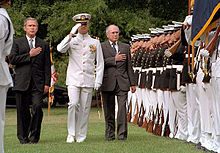ANZUS agreement

The ANZUS Agreement, named after the participating states Australia , New Zealand and the USA ( A ustralia, N ew Z ealand, U nited S tates ), also known as the Pacific Pact, was signed in San Francisco on September 1, 1951 . Came into force April 1952. The purpose of this agreement was to secure the Pacific region , originally primarily against a possible renewed Japanese aggression in the Far East . The pact was supplemented by the US- Philippines Defense Pact, which came into force at the same time , and expanded in 1955 by the Southeast Asia Pact with additional participation from France , Great Britain , Pakistan , the Philippines and Thailand with headquarters in Bangkok . The organ was the ANZUS Council, created in August 1952, consisting of the three foreign ministers .
On September 17, 1986, the United States terminated its treaty obligations to New Zealand. This happened due to the decision of the New Zealand Government under David Lange , nuclear-powered or nuclear -tipped ships and submarines to refuse the start-up of New Zealand ports, including those of the United States. Two years later, Australia and the United States agreed to keep the treaty between them, even though it was originally a tripartite alliance. The name ANZUS was retained.
See also
Web links
- Security Treaty between Australis, New Zealand, and the United States of America . In: Australian Treaty Series 1952 No 2 . Australasian Legal Information Institute(AustLII),accessed on August 19, 2016.
- The Australia, New Zealand and United States Security Treaty (ANZUS Treaty), 1951 . In: Office of the Historian . United States Department of State,accessed August 19, 2016.
Individual evidence
- ^ ANZUS treaty comes into force - April 29, 1952 . In: New Zealand History . Ministry for Culture & Heritage , accessed August 19, 2016 .
- ^ The Australia, New Zealand and United States Security Treaty (ANZUS Treaty), 1951 . In: Office of the Historian . United States Department of State , accessed August 19, 2016 .
